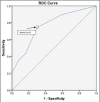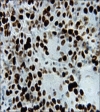Association of Micronuclear Frequency with Dysplasia and Cytogenetic Changes (p53 Mutation and p16 Expression) in Oral Potentially Malignant Disorders
- PMID: 35814878
- PMCID: PMC9262000
- DOI: 10.4103/joc.joc_198_21
Association of Micronuclear Frequency with Dysplasia and Cytogenetic Changes (p53 Mutation and p16 Expression) in Oral Potentially Malignant Disorders
Abstract
Aims: The present study evaluated the frequency of micronuclei in oral potentially malignant disorders (OPMDs) and their association with the presence of dysplasia on cytology and biopsy as well as their association with p53 mutation and p16 expression. Cytological findings of dysplastic changes in OPMDs were compared to histological diagnoses.
Material and methods: This was a cross-sectional, observational, descriptive study. Scrape smears (n = 74) were collected from lesions in patients with OPMDs. Punch biopsy was collected in patients showing dysplastic changes. Tissue microarray for p53 mutation and p16 expression was performed using paraffin embedded blocks. Cases were classified into grades of dysplasia using both scrape smears and biopsy. Micronuclei frequency was calculated per 100 cells using scrape smears. Mann-Whitney U test was used for correlation of cytology and histology for grade of dysplasia as well as micronuclear frequency with p53 mutation and p16 expression.
Results: Micronuclear frequency was found to be increased in patients with dysplasia. A significant association of micronuclear frequency with dysplastic changes was seen on cytology. Sensitivity of cytological evaluation was found to be 64.7%. The association of the micronuclear frequency of samples with p53 mutation and p16 expression was nearly significant (n = 28, P = 0.069 and 0.095, respectively).
Conclusion: Micronuclear frequency can be a reliable marker of mutagenic change in OPMDs. Cytological assessment of micronuclei can serve as useful, non-invasive, and relatively inexpensive tool to predict cancerous changes in OPMDs.
Keywords: Micronuclei; OPMD; p16 expression; p53 mutation.
Copyright: © 2022 Journal of Cytology.
Conflict of interest statement
There are no conflicts of interest.
Figures





Similar articles
-
Immunohistochemical expression of p53, p16 and hTERT in oral squamous cell carcinoma and potentially malignant disorders.Braz Oral Res. 2011 Jan-Feb;25(1):34-41. doi: 10.1590/s1806-83242011000100007. Braz Oral Res. 2011. PMID: 21359449
-
Expression of p16, p53 and Ki-67 proteins in the progression of epithelial dysplasia of the oral cavity.Anticancer Res. 2008 Sep-Oct;28(5A):2535-9. Anticancer Res. 2008. PMID: 19035275
-
p53 and p16 in oral epithelial dysplasia and oral squamous cell carcinoma: A study of 208 cases.Indian J Pathol Microbiol. 2016 Apr-Jun;59(2):153-8. doi: 10.4103/0377-4929.182037. Indian J Pathol Microbiol. 2016. PMID: 27166031
-
A systematic scoping review on utility of cytomorphometry in the detection of dysplasia in oral potentially malignant disorders.J Oral Biol Craniofac Res. 2020 Oct-Dec;10(4):321-328. doi: 10.1016/j.jobcr.2020.06.016. Epub 2020 Jul 3. J Oral Biol Craniofac Res. 2020. PMID: 32714783 Free PMC article.
-
[Usefulness of oral exfoliative cytology for the diagnosis of oral squamous dysplasia and carcinoma].Minerva Stomatol. 2004 Mar;53(3):77-86. Minerva Stomatol. 2004. PMID: 15107778 Review. Italian.
References
-
- Mehrotra R. The role of cytology in oral lesions: A review of recent improvements. Diagn Cytopathol. 2012;40:73–83. - PubMed
LinkOut - more resources
Full Text Sources
Research Materials
Miscellaneous
